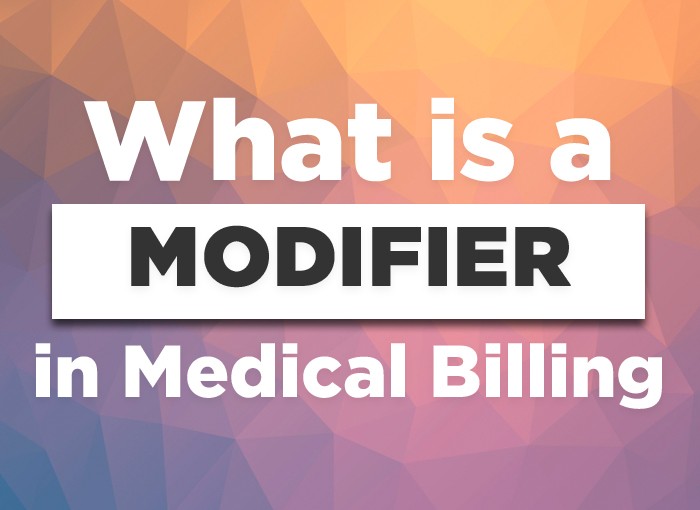What is a Modifier in Medical Billing?
Medical billing is a complicated field that includes correct documentation and conversation of healthcare offerings supplied to sufferers. One essential detail in this procedure is the use of modifiers. Modifiers are -person codes that offer additional information about a system or carrier without changing its definition. They play a crucial position in ensuring correct compensation and compliance with payer guidelines. Let’s dive into what modifiers are, their importance, and how they affect clinical billing.
CPT Modifiers
A CPT modifier is a two-digit numeric code. The CPT modifier is used to give additional information on medical procedures describing the need to use medical procedures, the site of the procedure, the change in procedure, and the total number of surgeons performing the procedure. All of this information is represented in the format ‘CPT code-modifier’ and forwarded to the insurance payer. For example, 24115-52 is used to represent reduced services by the physician for “excision or curettage of the bone cyst or benign tumor, humerus; with autograft (includes obtaining the graft)” due to minor complications.
Following are a few examples of CPT modifiers:
- 22 – Increased procedural services
- 23 – Unusual anesthesia
- 25 – Indicates a significant, separately identifiable evaluation and management (E/M) service by the same physician on the same day as another procedure.
- 50: Denotes a bilateral procedure.
- 52- Reduced services
- 53- Discontinued procedure
- 55- Postoperative management only
- 56- Preoperative management only
- 57- Decision for surgery
- 59- Distinct Procedural Services
- 99- Multiple modifiers
HCPCS Modifiers
An HCPCS modifier consists of two characters—one letter and one digit. HCPCS modifiers are grouped from the A to Z coding category. The HCPCS modifier is used to give additional information on specific items used to deliver non-physician services. All of this information is represented in the format ‘HCPCS code-modifier’ and forwarded to the insurance payer. For example, A0428-QN is used to represent “basic life support ambulance service, non-emergency transport, furnished by the provider of services.”
Following are a few examples of HCPCS modifiers:
- AA- Anesthesia services performed by anesthesiologists
- AD- Medical supervision by a physician, more than four concurrent anesthesia procedures
- AH- Clinical Psychologist (CP) Services. [Used when a medical group employs a CP and bills for the CP’s service]
- AJ- Clinical Social Worker (CSW). [Used when a medical group employs a CSW and bills for the CSW’s service]
- GW- Service not related to the hospice patient’s terminal condition
- GY- Item or service statutorily excluded or does not meet the definition of any Medicare benefit
- GZ- Item or service expected to be denied as not reasonable and necessary
- QN- Ambulance service furnished directly by a provider of services
Importance of Modifiers
Modifiers are vital for several reasons:
Ensuring Accurate Reimbursement:
Modifiers offer extra information that assists payers in apprehending the context of a carrier. This ensures proper fees and stops underpayment or overpayment.
Avoiding Claim Denials:
Incorrect or lacking modifiers can result in claim denials or delays. By the usage of the appropriate modifiers, you can decrease the chance of errors.
Compliance with Regulations:
Accurate use of modifiers guarantees compliance with payer-precise pointers, reducing the risk of audits or consequences.
Common Scenarios Where Modifiers Are Used
Modifiers are used in various scenarios, along with:
1. Bilateral Procedures
When the equal manner is carried out on each side of the frame, modifiers along with 50, LT, and RT assist make clear this.
2. Multiple Procedures
If a couple of processes are finished at some point of a single visit, modifiers like 51 or 59 simply this to the payer.
3. Unusual Circumstances
In instances in which a system requires more time, effort, or complexity than normal, modifiers like 22 (increased procedural services) are used.
4. Repeat Procedures
Modifiers together with 76 (repeat system by the equal health practitioner) and 77 (repeat process by using some other health practitioner) indicate that a provider turned into repeated.
Tips for Using Modifiers Correctly
Using modifiers correctly requires attention to elements and radical know-how of payer necessities. Here are a few suggestions:
Stay Updated:
Guidelines for modifiers can alternate. Regularly overview updates from the AMA and CMS.
Verify Payer Policies:
Different payers may additionally have precise necessities for certain modifiers. Always check the payer’s coverage earlier than filing a claim.
Use Supporting Documentation:
Provide adequate documentation to justify using modifiers. This allows at some stage in audits and guarantees correct repayment.
Leverage Technology:
Use billing software with integrated validation equipment to capture modifier-associated errors earlier than submission.
Common Mistakes to Avoid
Even experienced medical billers can make mistakes with modifiers. Avoid these not-unusual errors:
Using Incorrect Modifiers:
Assigning the wrong modifier can lead to claim rejections or incorrect bills.
Omitting Necessary Modifiers:
Failing to include a required modifier may additionally bring about underpayment or denial.
Overusing Modifiers:
Adding pointless modifiers can raise pink flags during audits and result in potential compliance issues.
Ignoring Documentation:
Without proper documentation, the usage of certain modifiers can not be justified, which could result in claim denials.
Conclusion
Modifiers are an essential aspect of scientific billing, offering crucial information that clarifies the character of the services provided. By information on the sorts of modifiers, their packages, and high-quality practices for their use, medical billers can make sure of accurate claim submission and repayment. Remember, attention to detail and non-stop training are key to mastering the usage of modifiers in clinical billing.
By prioritizing accuracy and compliance, you could streamline the billing manner, reduce claim denials, and make contributions to the monetary health of your healthcare employer.



